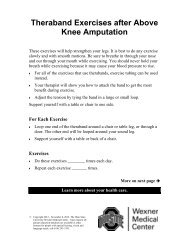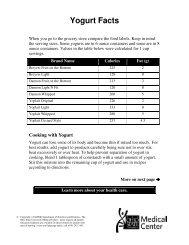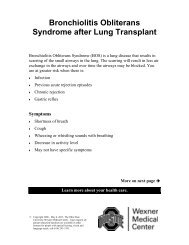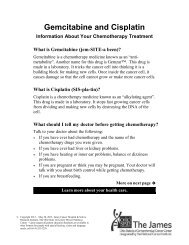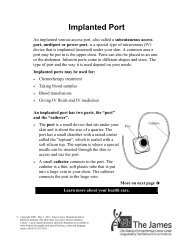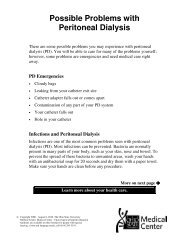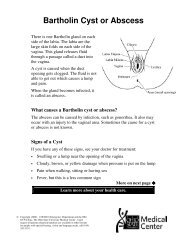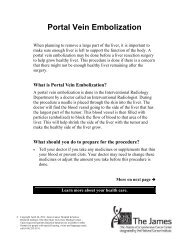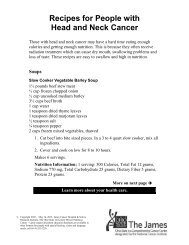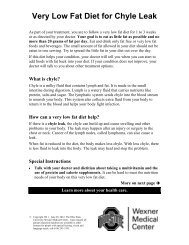General Care for Your Baby - Patient Education Home
General Care for Your Baby - Patient Education Home
General Care for Your Baby - Patient Education Home
You also want an ePaper? Increase the reach of your titles
YUMPU automatically turns print PDFs into web optimized ePapers that Google loves.
<strong>General</strong> <strong>Care</strong> <strong>for</strong> <strong>Your</strong> <strong>Baby</strong><br />
Picking Up or Lifting<br />
Use both hands to support your baby's head and neck when<br />
you lift your child.<br />
One way of picking up your baby is to place the palm of<br />
one hand under the baby's head and neck. Slide the palm of<br />
the other hand under the baby's bottom and gently lift.<br />
This technique is useful when picking your baby up<br />
from a flat surface, such as a changing table or crib.<br />
Another way to pick up your baby is to slide both hands<br />
under the baby's back using your fingers to support the<br />
head and neck. <strong>Your</strong> thumbs should be across the baby's<br />
chest, holding firmly. This method is useful when lifting<br />
the baby from a semi-upright position. The semi-upright<br />
position is common when the baby is in an infant seat or<br />
swing.<br />
Holding<br />
There are three basic positions used <strong>for</strong> holding. These are the<br />
cradle, football, and the over the shoulder holds.<br />
Cradle hold: Place the baby in your <strong>for</strong>earm nestling the<br />
baby's head in the bend of your elbow. Use your wrist and<br />
hand to support the baby's bottom and lower spine.<br />
© Copyright 2000 - April 20, 2012. The Ohio State<br />
University Wexner Medical Center - Upon request all<br />
patient education handouts are available in other<br />
<strong>for</strong>mats <strong>for</strong> people with special hearing, vision and<br />
language needs, call (614) 293-3191.<br />
Learn more about your health care.<br />
More on next page
Page 2<br />
The football hold allows you to hold the baby with one arm while<br />
the other arm can move freely. Place one hand under the baby's<br />
head and neck. Slide the baby's bottom between your elbow and<br />
hip in a tucked position.<br />
The over the shoulder hold is also known as<br />
the burping position. Place your baby high<br />
enough so the baby’s chest rests on your<br />
shoulder. Use one hand to support the baby's<br />
head and neck and place the other under the<br />
baby's bottom to support the body.<br />
Safe Sleep<br />
Place your infant on his or her back when sleeping. When sleeping or<br />
taking naps, back sleeping reduces the risk of Sudden Infant Death<br />
Syndrome (SIDS). As your baby gets older tummy time will be<br />
recommended to develop neck and stomach muscles. Ask your baby's<br />
doctor about the position that is safest <strong>for</strong> your baby.<br />
Use infant sleep sacks or blanket sleepers. <strong>Your</strong> baby can stay warm<br />
and reduce the need <strong>for</strong> blankets in the crib.<br />
If blankets are used, place the blanket no higher than your baby’s chest<br />
and tuck in the blanket securely under the bottom and sides of crib<br />
mattress. This will reduce the chance of your baby pulling the blanket<br />
over his or her head when sleeping.<br />
Do not over bundle your baby in clothing when sleeping. Light clothing<br />
is best.<br />
Temperature in the room should be com<strong>for</strong>table <strong>for</strong> a lightly clothed<br />
adult.<br />
For more in<strong>for</strong>mation, review the handout: Sudden Infant Death<br />
Syndrome (SIDS).
Choosing Clothing <strong>for</strong> <strong>Your</strong> <strong>Baby</strong><br />
Make sure clothing is roomy and com<strong>for</strong>table. Avoid<br />
tight collars, sleepers that are too small, or clothes with<br />
dangling strings and ties. Clothes made of stretchy<br />
fabrics are best <strong>for</strong> a newborn. Remember, babies grow<br />
out of clothing very fast and clothing sizes can be very<br />
misleading.<br />
Choose simple clothes with easy-on and easy-off<br />
features, such as snaps or zippers. Avoid clothing with<br />
many buttons. Use undershirts that tie or snap at the<br />
side. Try clothing with snap crotches and legs that<br />
allow you to change your baby’s diaper without<br />
removing the clothes. This will make dressing easier.<br />
Cotton clothing is a good choice <strong>for</strong> a baby's clothes.<br />
Cotton fabric absorbs moisture, allows air to circulate,<br />
and keeps the baby com<strong>for</strong>table.<br />
All infant-wear should be flame retardant. The clothing<br />
label should state whether the clothes have been treated.<br />
Dressing<br />
Dress your baby on a flat surface such as a changing<br />
table, crib mattress or bed.<br />
Allow dressing to be play time. This will distract<br />
your baby enough to make cooperation more likely.<br />
Stretch the neck opening of garments and ease it<br />
over the baby's head. Avoid snagging the ears or<br />
nose.<br />
Reach into the sleeves of garments and gently pull<br />
the baby's arm through to the other end. Avoid<br />
pulling or tugging the arms or legs.<br />
Draw the garment away from the baby's body when<br />
pulling a zipper up or down to avoid pinching the<br />
skin.<br />
Page 3
Page 4<br />
Dress your baby appropriately <strong>for</strong> the season of the year. Hats that cover<br />
the ears are essential in cold weather. In the summer, a hat with a brim will<br />
protect the baby's eyes, head and face from over exposure to the sun. It is<br />
not recommended that you use sunscreen on your baby until 6 months<br />
of age.<br />
Check your baby's hands and feet <strong>for</strong> body temperature. Cold hands and<br />
feet show the need <strong>for</strong> more warmth. Hot sweaty hands and feet say the<br />
baby may need less clothing or a cooler environment.<br />
If your baby is under 8 pounds at discharge from the hospital, add an extra<br />
layer <strong>for</strong> warmth like a blanket.<br />
How to Trim <strong>Your</strong> <strong>Baby</strong>'s Nails<br />
Here are some helpful hints on trimming your baby's nails:<br />
Use clean baby nail clippers or baby scissors.<br />
Work in a well lit area.<br />
Trim only the tips of the nails. Use a nail file to smooth rough edges.<br />
Nail trimming is easily done when the baby is asleep. Have another<br />
person help you when the baby is awake.<br />
Even if you follow these steps, you may draw blood from the fingers or<br />
toes. If bleeding occurs, apply pressure to the area until the bleeding<br />
stops, using a clean cloth. Keep the nail area clean and dry.<br />
Talk to your doctor or others on your health care team if you have<br />
questions. You may ask <strong>for</strong> more written in<strong>for</strong>mation from the<br />
Library <strong>for</strong> Health In<strong>for</strong>mation at (614) 293-3707 or email:<br />
health-info@osu.edu.





